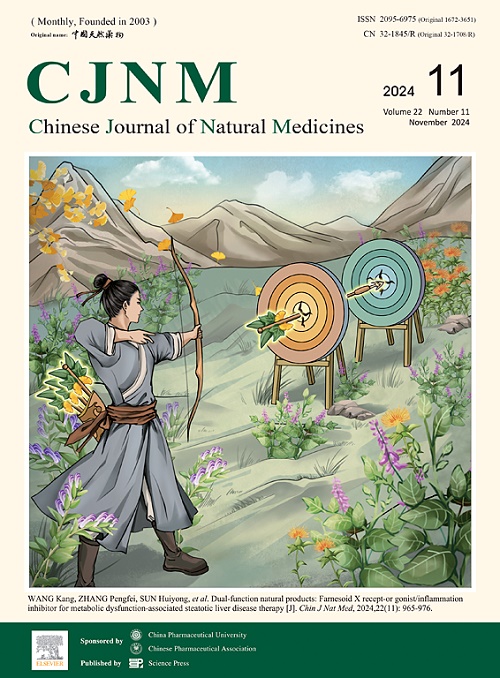New acylphloroglucinol-sesquiterpenoid adducts with antiviral activities from Dryopteris atrata
IF 4.9
2区 医学
Q1 INTEGRATIVE & COMPLEMENTARY MEDICINE
引用次数: 0
Abstract
Seven novel acylphloroglucinol-sesquiterpenoid adducts, designated as dryatraols J–P (1–7), were isolated from the rhizomes of Dryopteris atrata (Wall. ex Kunze) Ching. The structures, including absolute configurations, were elucidated using comprehensive spectroscopic data, calculated 13C Nuclear Magnetic Resonance-Diastereotopic Probability Assignment Plus (13C NMR-DP4+) probability analysis, and ECD calculations. These structures represent a rare subclass of carbon skeleton of acylphloroglucinol-sesquiterpenoid adducts with a furan ring connecting the acylphloroglucinol and sesquiterpenoid moieties. Notably, compounds 1–6 are the first reported examples of acylphloroglucinol-sesquiterpenoid adducts with dimeric acylphloroglucinol incorporated into the aristolane- or rulepidanol-type sesquiterpene, while compound 7 features a hydroxylated monomeric acylphloroglucinol motif. A preliminary evaluation of their antiviral activities revealed that compounds 1–6 exhibited more potent activities against respiratory syncytial virus (RSV) with IC50 values ranging from 0.75 to 3.12 μmol·L−1 compared to the positive control (ribavirin).
具有抗病毒活性的新乙酰间苯三酚倍半萜加合物
从水芹(Dryopteris atrata (Wall))的根状茎中分离到7个新的酰基间苯三酚倍半萜类加合物,命名为dryatraol J-P(1-7)。(原Kunze) Ching。利用综合光谱数据,计算13C核磁共振-非对映位概率分配加(13C NMR-DP4+)概率分析和ECD计算,阐明了其结构,包括绝对构型。这些结构代表了一种罕见的酰基间苯三酚-倍半萜类加合物的碳骨架亚类,其呋喃环连接酰基间苯三酚和倍半萜类的部分。值得注意的是,化合物1-6是首次报道的酰基间苯三酚-倍半萜类加合物与二聚体酰基间苯三酚结合到马托耳烷或规则皮醇型倍半萜类中,而化合物7具有羟基化的单体酰基间苯三酚基序。初步测定化合物1 ~ 6对呼吸道合胞病毒(RSV)的抗病毒活性,IC50值为0.75 ~ 3.12 μmol·L−1,高于阳性对照(利巴韦林)。
本文章由计算机程序翻译,如有差异,请以英文原文为准。
求助全文
约1分钟内获得全文
求助全文
来源期刊

Chinese Journal of Natural Medicines
INTEGRATIVE & COMPLEMENTARY MEDICINE-PHARMACOLOGY & PHARMACY
CiteScore
7.50
自引率
4.30%
发文量
2235
期刊介绍:
The Chinese Journal of Natural Medicines (CJNM), founded and sponsored in May 2003 by China Pharmaceutical University and the Chinese Pharmaceutical Association, is devoted to communication among pharmaceutical and medical scientists interested in the advancement of Traditional Chinese Medicines (TCM). CJNM publishes articles relating to a broad spectrum of bioactive natural products, leading compounds and medicines derived from Traditional Chinese Medicines (TCM).
Topics covered by the journal are: Resources of Traditional Chinese Medicines; Interaction and complexity of prescription; Natural Products Chemistry (including structure modification, semi-and total synthesis, bio-transformation); Pharmacology of natural products and prescription (including pharmacokinetics and toxicology); Pharmaceutics and Analytical Methods of natural products.
 求助内容:
求助内容: 应助结果提醒方式:
应助结果提醒方式:


